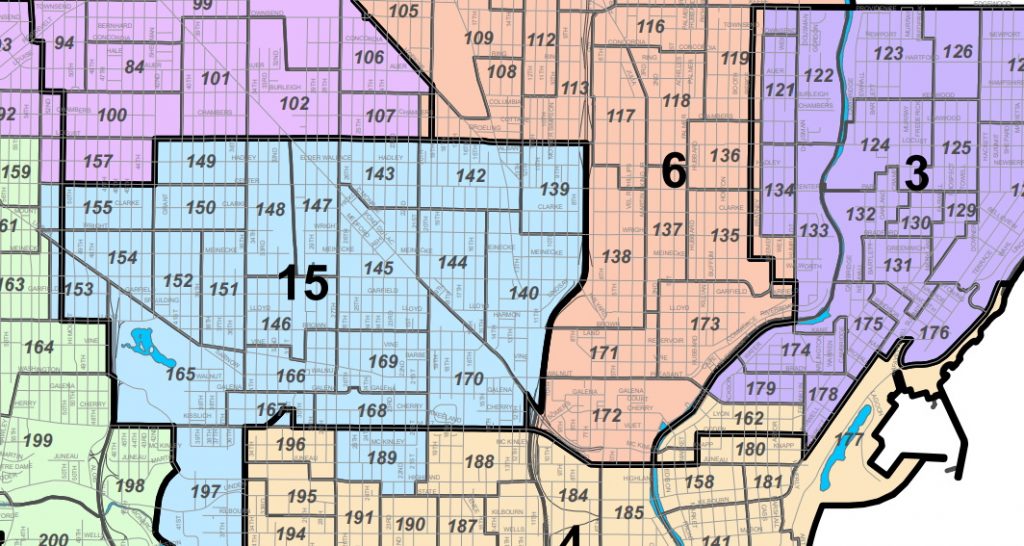Council Okays ‘Warp Speed’ Redistricting
City officials forced to work quickly, with one council member objecting to new plan.
The City of Milwaukee has new districts for all 15 council seats.
And despite the fact that districts won’t be used until 2024, the Common Council introduced and adopted the new map in less than a week.
The final map was adopted on 14-1 vote Tuesday morning with only Alderwoman JoCasta Zamarripa in opposition.
The city experienced a net population loss (17,611) in the past decade, but in an uneven manner. The result is that districts that lost population, particularly those on the North Side, must expand their footprint while others must contract.
The city is now 39.3% Black, 32.3% white, 20.1% Hispanic and 5.6% Asian. When considering only the voting age population, the city is 38.6% white, 36.1% Black, 17.6% Hispanic and 5.1% Asian.
The resulting districts maintain the balance of six Black majority districts, two Hispanic districts and five white districts of which two are being described as Hispanic “influence” districts. There is no legal definition for an “influence” district, but the council is informally defining it as a 25% voting bloc.
So why did Zamarripa vote against the proposal?
“I heard from community members… there were issues raised in particular with the Latino numbers and what that could mean for redistricting,” said Zamarripa in an interview.
She said she agreed with the Legislative Reference Bureau’s assessment that drawing three-majority Hispanic would be difficult.
Ald. Scott Spiker’s southside district, the 13th, and the one to the north, the 14th represented by Alderwoman Marina Dimitrijevic, will now have voting-age Hispanic populations of 25.6% and 28.1% respectively. Their white voting-age populations are 57.4% and 62.4%.
Zamarripa said she would have preferred that the 13th district have a stronger Latino influence, likely being pulled from the 14th district.
“I used to represent this area in the Assembly and I know full well the low voter turnout, unfortunately, in the Latino areas and we are always drowned out by the high, affluent highly civic engaged of non-Latinos on the southeast side of the 14th district,” she said, describing Bay View.
The alderwoman, first elected in April 2020, said she was contacted by community stakeholders including former UMOS executive director Jesus Salas, Forward Latino director Darryl Morin and Milwaukee Election Commission deputy director Jonatan Zuniga.
She said she was thankful they reached out and disappointed that the county board put the city in a tight spot by delaying its process.
LRB said the maps were drawn to comply with the federal Voting Rights Act and that efforts were also made to keep neighborhoods together by following major streets, rivers and other barriers. The smallest and largest districts must not be more than 10% different in size.
The new district map will go into effect for the 2024 spring elections for all 15 council seats. Any special election occurring before that time, under state law, would occur with new wards, but under the prior district lines. The election commission would need to accommodate or restrict voters in the new, redrawn wards so that those voting align with those eligible under the prior districts.
The council adopted a new ward map last week which will impact where and with whom residents vote beginning with the spring 2022 elections.
The terms Latino and Hispanic were used interchangeably in this piece to represent the comments of a speaker or the wording of a document.
Maps and Statistics
- Adopted District Map – Detailed
- Adopted District Map – 11×17
- Adopted District Map Demographics
- Adopted 2021 City Ward Map
- 2012 Ward Map
- 2012 Common Council Districts
- 2000 to 2010 Population Change by Aldermanic District
- 2010 to 2020 Population Change by Aldermanic District
- 2020 Population Change by Wards
- 2020 Aldermanic District Demographics
If you think stories like this are important, become a member of Urban Milwaukee and help support real, independent journalism. Plus you get some cool added benefits.
More about the Milwaukee County redistricting process
- Op Ed: Muslim Community Needs Representation - Janan Najeeb - Jan 29th, 2022
- City Hall: Council Ends Redistricting With Anger, Tears - Jeramey Jannene - Jan 18th, 2022
- Statement from Milwaukee Mayor Cavalier Johnson - Mayor Cavalier Johnson - Jan 18th, 2022
- City Hall: Latino Leaders Could Sue Over Redistricting - Jeramey Jannene - Jan 14th, 2022
- Latinx Leaders Condemn Common Council’s Refusal to Draw New Districts Reflecting Dramatic Growth of Latinx Population; Demand Second Legal Opinion - Voces de la Frontera - Jan 14th, 2022
- Voces de la Frontera Statement on Redistricting Decision - Voces de la Frontera - Jan 11th, 2022
- Statement on redistricting decision - JoCasta Zamarripa - Jan 10th, 2022
- City Hall: Milwaukee Starts Over On Redistricting, Only To Adopt Same Map Again - Jeramey Jannene - Jan 10th, 2022
- Statement by Milwaukee Mayor Tom Barrett: - Mayor Tom Barrett - Dec 14th, 2021
- City Hall: Council Halts Redistricting After Latino Pushback - Jeramey Jannene - Dec 14th, 2021
Read more about Milwaukee County redistricting process here
Political Contributions Tracker
Displaying political contributions between people mentioned in this story. Learn more.
- December 31, 2019 - JoCasta Zamarripa received $50 from Nikiya Dodd
- December 31, 2019 - Marina Dimitrijevic received $50 from Nikiya Dodd
- October 30, 2019 - JoCasta Zamarripa received $100 from Darryl Morin
- August 30, 2019 - Marina Dimitrijevic received $50 from Jesus Salas
- June 30, 2019 - JoCasta Zamarripa received $200 from Darryl Morin
- June 24, 2019 - JoCasta Zamarripa received $125 from Jesus Salas
- June 24, 2019 - JoCasta Zamarripa received $25 from Jonatan Zuñiga
- May 29, 2019 - JoCasta Zamarripa received $250 from Darryl Morin
- April 24, 2019 - JoCasta Zamarripa received $50 from Jesus Salas
- January 13, 2016 - Ashanti Hamilton received $20 from Nikiya Dodd
City Hall
-
Council Blocked In Fight To Oversee Top City Officials
 Dec 16th, 2025 by Jeramey Jannene
Dec 16th, 2025 by Jeramey Jannene
-
Latest Effort to Adopt New Milwaukee Flag Going Nowhere
 Dec 3rd, 2025 by Jeramey Jannene
Dec 3rd, 2025 by Jeramey Jannene
-
After Deadly May Fire, Milwaukee Adds New Safety Requirements
 Dec 2nd, 2025 by Jeramey Jannene
Dec 2nd, 2025 by Jeramey Jannene





















